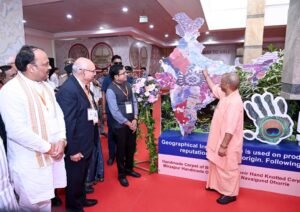How India’s trade deal with EFTA is unlocking investment, jobs, and global market access

India’s trade policy reached a significant milestone on October 1, with the enforcement of the Trade and Economic Partnership Agreement (TEPA) between India and the European Free Trade Association (EFTA). This agreement, originally signed on March 10, 2024, in New Delhi, marks India’s first Free Trade Agreement (FTA) with a group of four developed European countries: Switzerland, Norway, Iceland, and Liechtenstein.
TEPA stands out as one of India’s most forward-looking trade deals, not only because of the scale of market access it promises, but also due to the depth of commitments made by both parties. Most notably, the agreement includes a binding commitment from EFTA nations to invest USD 100 billion into the Indian economy over the next 15 years. This is accompanied by the creation of one million direct jobs in India, a first in any FTA signed by the country.
The investment component is structured in two phases, USD 50 billion is to be invested within the first 10 years, followed by another USD 50 billion over the next five years. These investments are not in volatile or short-term sectors, but rather focus on long-term capacity building in key areas such as renewable energy, life sciences, advanced engineering, digital technologies, and innovation-driven manufacturing. In order to facilitate and manage this influx of investment, a dedicated India–EFTA Desk has been established and operational since February 2025. This single-window mechanism aims to provide investor support, encourage joint ventures, and promote collaboration, particularly among small and medium enterprises.
Market access is another cornerstone of TEPA. EFTA countries have eliminated tariffs on 92.2 percent of their tariff lines, which cover 99.6 percent of India’s exports to these nations. This is highly beneficial for Indian exporters, especially in non-agricultural goods, processed food items, and industrial sectors. In return, India has offered tariff concessions on 82.7 percent of its tariff lines, which represent 95.3 percent of EFTA’s exports. However, India has ensured strong protection for sensitive sectors including dairy, soya, coal, certain pharmaceuticals, medical devices, and key agricultural products. These items have either been excluded from the agreement or are subject to phased tariff reductions over a 5–10 year period to allow domestic industries sufficient time to adjust and grow.
The agreement also brings a significant boost to India’s services sector, which currently accounts for more than 55 percent of the country’s Gross Value Added. India has made commitments in 105 services sub-sectors, while the EFTA countries have made offers across a wide range—128 by Switzerland, 114 by Norway, 110 by Iceland, and 107 by Liechtenstein. These include India’s core strengths such as IT and business services, education, professional consulting, and creative industries. TEPA is also the first Indian FTA to include Mutual Recognition Agreements (MRAs) in regulated professions like nursing, chartered accountancy, and architecture, making it easier for Indian professionals to work in EFTA countries.
The agreement facilitates trade in services through digital delivery, commercial presence in host countries, and temporary movement of skilled professionals. These measures are expected to enhance India’s competitiveness in global services trade, expand job opportunities for skilled workers, and deepen India’s participation in international talent and technology networks.
TEPA’s intellectual property provisions are also noteworthy. While reaffirming obligations under the WTO’s TRIPS agreement, the deal ensures India retains the flexibility to protect public health and access to affordable generic medicines. The inclusion of safeguards against patent evergreening is a deliberate policy choice to balance innovation with social inclusion, especially in critical sectors like pharmaceuticals.
In addition to economic gains, TEPA also reflects a shared commitment to sustainability, inclusive development, and transparency in trade procedures. Both India and the EFTA states have agreed to promote trade practices that are environmentally responsible and socially inclusive. The agreement calls for simplification and harmonization of customs procedures, increased use of digital tools, and alignment with global sustainability standards. This positions TEPA as not only a trade agreement but also a platform for climate-aligned industrial cooperation.
The sector-wise benefits of TEPA are already beginning to take shape. In agriculture, the removal or reduction of tariffs has opened new markets for Indian products like guar gum, basmati rice, grapes, and pulses. Switzerland and Norway, which together account for over 99 percent of India’s agri-exports to the EFTA region, have removed import duties on fresh grapes, nuts, seeds, and processed vegetables. Iceland has eliminated high tariffs on chocolates, confectionery, and fresh produce.

India’s coffee and tea producers also stand to benefit. EFTA countries import around USD 175 million worth of coffee annually, and the removal of all duties now makes Indian coffee more competitive in premium markets like Switzerland and Norway. In tea, a small but high-value market, India’s export earnings per kilogram rose significantly in 2024–25, a clear indication of improved price realization post-agreement.
Marine products will also see gains, especially in Norway and Iceland. These countries have removed or reduced tariffs on a variety of Indian seafood exports, including shrimp, squid, fish feed, and fish oils. These measures are expected to increase India’s share in EFTA’s seafood import market and improve returns for Indian fishers and processors.
In manufacturing, the TEPA agreement is a clear win for Indian exporters. Engineering goods exports to EFTA rose by 18 percent in FY 2024–25 to USD 315 million, and this trend is expected to accelerate. Products such as electrical machinery, copper components, and precision tools will now face lower or zero tariffs, making them more attractive in the European market. The electronics sector, particularly MSMEs and OEMs in diagnostics, wearables, fintech modules, and EV components, stands to benefit from lower trade barriers and enhanced IPR protections.
India’s traditional strengths in textiles, leather, and gems and jewellery have also received a boost. Duty stability and easier conformity standards make Indian textiles and leather goods more competitive, while the elimination of tariffs on diamonds, gold jewellery, and coloured gemstones secures long-term access to high-income markets in Switzerland and Liechtenstein.
In chemicals, plastics, and allied sectors, the agreement offers zero or reduced tariffs on 95 percent of Indian exports. Pre-FTA duties in these sectors were as high as 54 percent. Post-agreement, exports are projected to grow from USD 49 million to over USD 70 million, with notable potential in rubber, ceramics, glassware, and plastic goods.
The TEPA agreement is also a model of trust-based cooperation between countries that value transparency, legal stability, and responsible economic development. It reflects a strategic alignment between India’s development goals and the EFTA bloc’s interest in building resilient, diversified partnerships in a shifting global trade landscape.
Overall, the India–EFTA TEPA agreement marks a new phase in India’s global trade journey. With its binding commitments on investment and employment, careful balancing of market access, and forward-looking approach to services, innovation, and sustainability, TEPA serves as a template for India’s future trade negotiations. As the country prepares for deeper economic engagement with other regions, including the European Union, the UK, and the Gulf countries, this agreement sets a high benchmark for ambition, balance, and long-term impact.
By combining economic openness with national interest safeguards, the government has shown that it is possible to pursue trade liberalization while still protecting domestic sectors, generating employment, and promoting inclusive growth. TEPA, therefore, is not only an agreement on paper, it is a strategic lever for India’s next stage of economic transformation.









